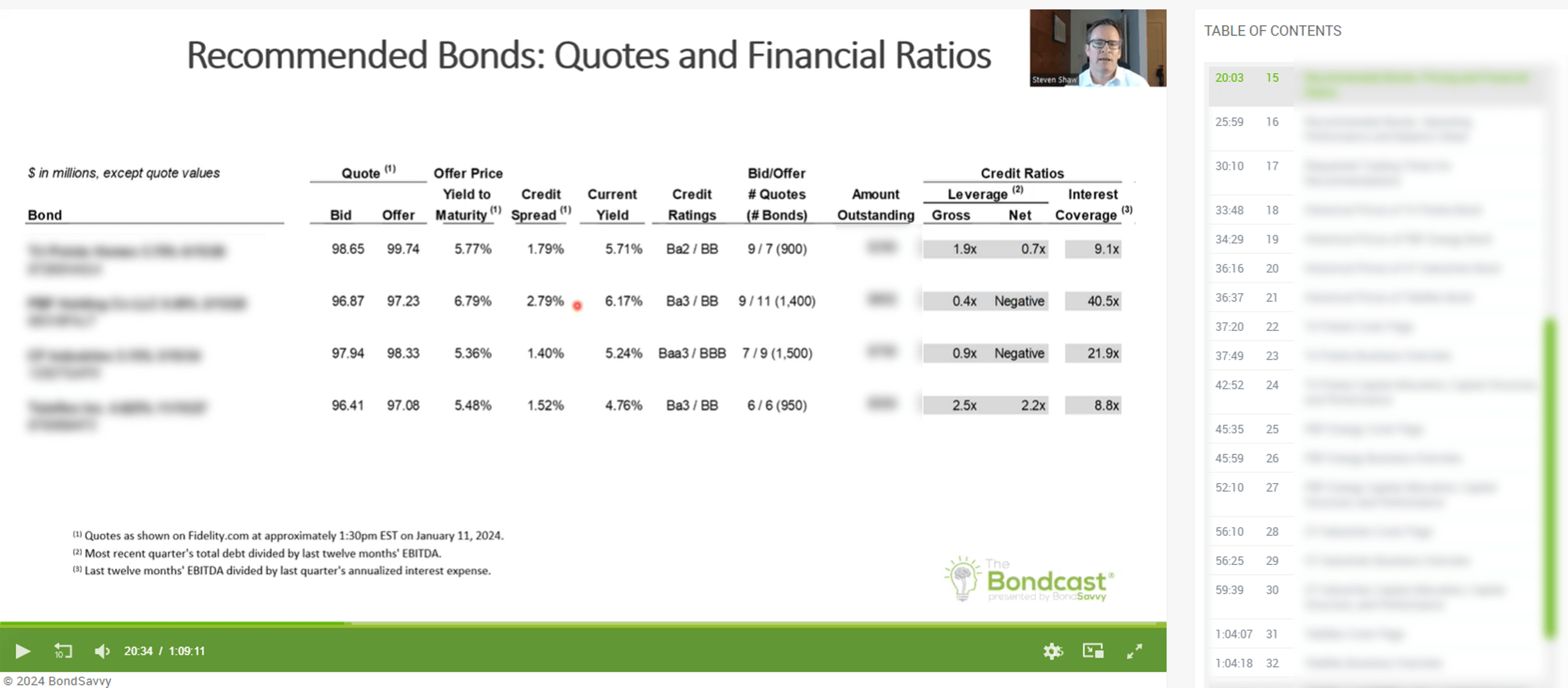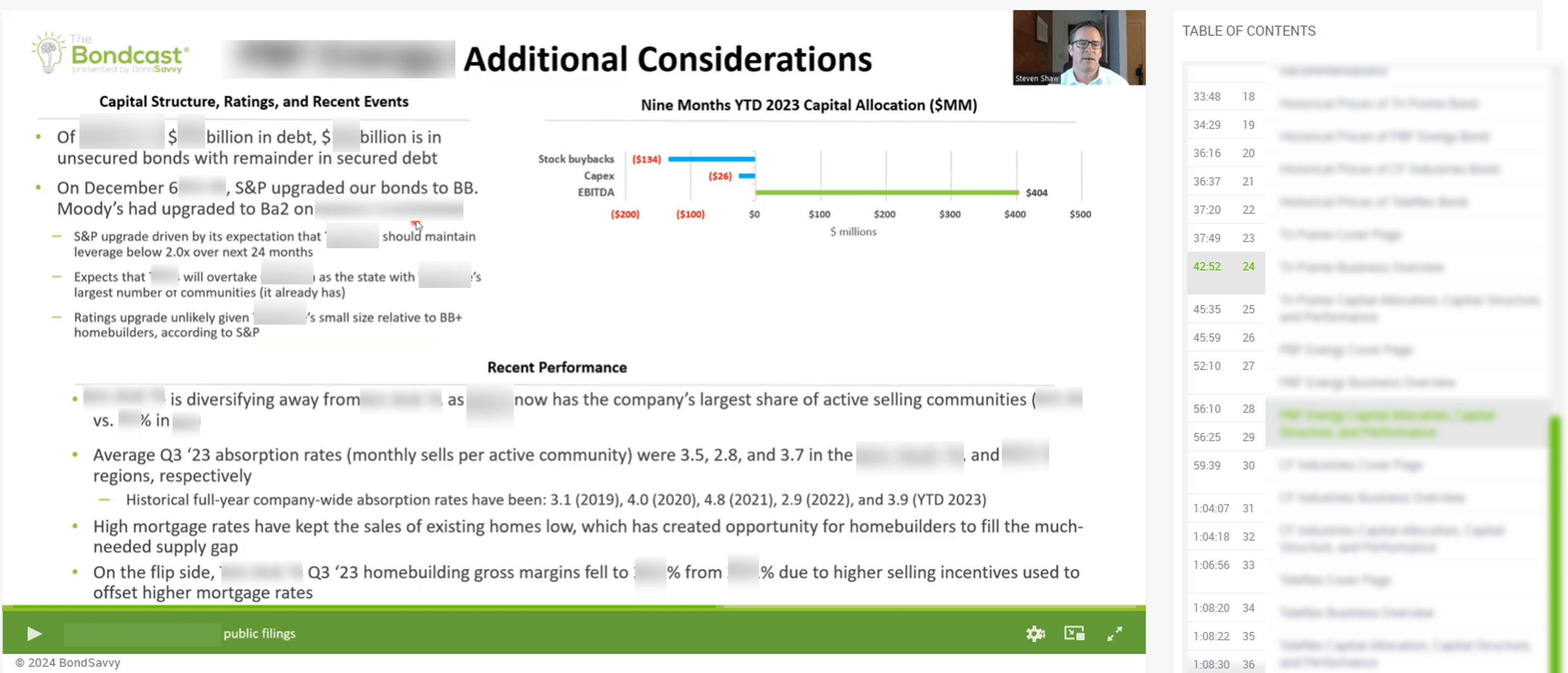On April 4, 2024, Bondsavvy founder and fixed income expert Steve Shaw presented four new corporate bond recommendations to Bondsavvy subscribers. These four bond recommendations, along with the other four bond picks we made on January 11, 2024, are our best corporate bonds to buy 2024.
On April 26, 2024, all eight of these recommended bonds were available at prices near of slightly below the pick date price and had yields to maturity ranging from 5.85% to 6.75%. Apart from these eight new bond recommendations, Bondsavvy currently has 67 bonds rated either buy or hold, with 36 rated "buy."
This fixed income blog post previews our eight new corporate bond recommendations, as well as all 67 bonds we rate buy or hold. Key takeaways include:
- Of our 67 buy/hold corporate bond recommendations, 39 had YTMs of at least 6.00% on April 11, 2024 (see Figures 2 and 3)
- Seven of our eight best bonds to buy 2024 had leverage ratios of 2.2x or less (see Figure 1)
- Our recommended list included 38 high yield bonds and 29 investment grade bonds
- Our 67 corporate bond recommendations include issuers across 16 industry groups (see Figure 6)
- Of our 67 bond recommendations, 35 have maturity dates of 2032 and earlier (see Figures 7 and 8)
- Individual corporate bonds enable investors to lock in high income for longer than is possible with money market funds and bond funds
Our Best Bonds To Buy 2024 Preview
Bondsavvy's eight new corporate bond recommendations include bonds issued by companies in the medical devices,
homebuilding, energy, agriculture, technology, leisure, and mining industries. Three of these new recommendations had triple-B bond ratings ("investment grade") and
five had double-B bond ratings ("below investment grade" or "high yield"). Of these eight most recent bond recommendations, three bonds had
2027 or 2028 maturity dates; four had 2033-2034 maturity dates; and one bond was due beyond 2040.
Subscribe to Bondsavvy to learn the names and CUSIPs of all of the 67 corporate bonds we rated buy or hold as of April 26, 2024.
Figure 1 shows how, as of April 26, 2024, our best bonds to buy 2024 were trading near or slightly below their pick date prices. It also shows the range of bond YTMs and issuing company leverage ratios.
Figure 1: Bond Prices of Our Best Corporate Bonds To Buy 2024 -- Pick Date vs. April 26, 2024
| Pick Date Offer Price | April 26, 2024 Offer Price | April 26, 2024 Offer YTM | Issuer Leverage Ratio* | |
|---|---|---|---|---|
| April 4, 2024 Bond Recommendations | ||||
| Investment Grade Bond 1 | 102.54 | 99.98 | 6.35% | 1.3x |
| High Yield Bond 1 | 98.23 | 96.53 | 5.85% | 1.1x |
| Investment Grade Bond 2 | 104.30 | 101.74 | 6.05% | 0.9x |
| High Yield Bond 2 | 103.93 | 101.33 | 6.75% | 3.2x |
| January 11, 2024 Bond Recommendations | ||||
| High Yield Bond 1 | 99.74 | 96.98 | 6.55% | 2.2x |
| High Yield Bond 2 | 97.23 | 97.87 | 6.64% | 0.5x |
| Investment Grade Bond 2 | 98.33 | 94.61 | 5.88% | 1.1x |
| High Yield Bond 3 | 97.08 | 95.56 | 6.03% | 2.2x |
Sources: Pricing data are from Fidelity.com. *Leverage ratios are Bondsavvy calculations based on company SEC filings. We calculated leverage ratios based on the issuing company's most recently reported financials in advance of the Pick Date.
A key part of our fixed income investment strategy is to identify bonds with high coupons relative to their risk and with upside potential. As shown in Figure 1, seven of the eight best bonds to buy 2024 had leverage ratios of 2.2x or less, a conservative level. In some cases, bonds rated below investment grade can have lower leverage ratios than those issued by investment grade companies. These are the types of opportunities where investors can capture a higher potential total return with limited default risk.
Can I Still Buy the Recommended Bonds Near the Pick Date Price?
As shown in Figure 1, as of April 26, 2024, the answer is 'yes.' Our goal is for Bondsavvy subscribers to be able to purchase our recommended bonds at or near the recommended prices. As our subscriber base grew, in March 2021, we implemented several actions to limit the market impact of our bond recommendations. To date, these actions have been successful.
Owning individual bonds vs. bond funds is the more cost-effective way to invest in bonds, as investors do not pay recurring fees based on a percentage of what they invest. In addition, bond funds incur significant trading costs. Bond funds do not disclose the amount of these costs and exclude them from the "expense ratio" fund managers, such as Vanguard, trumpet. By taking actions to limit our market impact, we have enabled our subscribers to purchase bonds at competitive prices and to maximize their corporate bond returns.
Yields to Maturity Summary of Our Buy/Hold Recommendations
On April 11, 2024, the 67 bonds we rated either buy or hold included 38 high yield corporate bonds and 29 investment grade corporate bonds. Please note that we updated our buy/hold ratings on March 7, 2024 after companies reported their Q4 earnings. We will be updating the buy/sell/hold ratings of each current Bondsavvy recommendation during the May 30, 2024 edition of The Super Bondcast.
Figure 2 shows a distribution of YTMs of the 38 high yield corporate bonds on our buy/hold list. Our goal is, when possible, to achieve total returns that can exceed a corporate bond's YTM. A key part of accomplishing this involves selling bonds before maturity.
Figure 2: Distribution of High Yield Bond Yields to Maturity of Bondsavvy Recommendations -- As of April 11, 2024 (38 Bonds)

Source: Fidelity.com and FINRA TRACE data
Many investors favor investment grade corporate bonds vs. high yield bonds due to their perceived higher level of safety. While certain high yield corporate bonds may have higher default risk than investment grade bonds, high yield bonds generally have lower interest rate risk. This is due, in part, to their higher coupons, shorter-dated maturities, and higher credit spreads.
When the US Federal Reserve hiked interest rates in 2022 and 2023, the worst-performing bonds were generally investment grade corporate bonds due to their sensitivity to US Treasury yields. Many high yield corporate bond prices remained steady, with some even achieving positive returns.
In addition, investors should not be led to believe that all investment grade bonds have lower default risk than high yield bonds. As we discuss in our corporate bond ratings blog post and imbedded YouTube video, bond rating methodologies have flaws. There are many cases where bonds are rated investment grade despite the issuer having inferior financials to many high yield bond issuers.
Investors would be surprised that there are many investment grade issuers with leverage ratios above 4.0x and many high yield bond issuers with leverage ratios below 2.0x.
Figure 3 shows the distribution of April 11, 2024 YTMs across the 29 investment grade corporate bonds we rated buy or hold.
Figure 3: Distribution of Investment Grade Bond Yields to Maturity of Bondsavvy Recommendations -- As of April 11, 2024 (29 Bonds)

Source: Fidelity.com and FINRA TRACE data
While our investment grade corporate bond recommendations have, in general, lower YTMs than our high yield bonds, many of our investment grade bonds could achieve higher total returns than certain high yield corporate bonds.
There are two primary reasons for this. First, many of our investment grade corporate bonds now trade between 58% to 68% of their $1000 face value. While many of these bonds rallied in November and December 2023, these bonds have a long way to go until they reach par value. Should these bonds approach par value well in advance of their maturity dates, such bonds could achieve double-digit annual returns.
Bondsavvy Subscriber Benefit
How many hours per week can you spend evaluating corporate bond investments? Bondsavvy does the financial analysis for you and provides a select number of recommendations that can outperform the leading bond funds and ETFs.Get Started
In addition, investment grade bonds are generally not subject to bond call schedules in the way high yield corporate bonds are. Investment grade bonds typically have make-whole-call provisions. Such provisions are onerous to bond issuers and rarely invoked, which enables certain investment grade bonds to trade well above their par value. Since most high yield bonds are subject to call schedules, their upside is often limited when compared to investment grade corporate bonds.
Please read Section 6 of our when to sell bonds blog post for more information on the differences between call schedule bonds and make-whole-call bonds.
Why Own Our Best Corporate Bonds To Buy 2024
Owning individual corporate bonds enables investors to lock in high income for a specific time period and to have the opportunity for capital appreciation. Individual corporate bonds also, at maturity, provide for a return of the $1,000 face value for each bond you own. With individual corporate bonds, investors can build bond portfolios suited to their investment objectives and risk tolerance.
Since corporate bonds are priced as a percentage of their face value, investors can evaluate a bond's price, YTM, and credit spread and compare these metrics to the bond issuer's financials. This financial analysis is the heart of the Bondsavvy subscription and enables us to identify bonds that can achieve strong total returns over the long term. This analysis is not possible when investing in bond funds and ETFs, as we discuss below.
Bondsavvy Subscriber Benefit
Approximately 9,000 individual corporate bonds are available for online investing each day. Our corporate bond recommendations cut through the clutter to identify bonds that offer high coupons and upside potential relative to their risk.Get Started
A compelling alternative to money markets, CDs, and bond funds
In the March 2024 Fed dot plot, the US Federal Reserve projected 2.25 points of interest rate cuts through 2026. Should this happen, popular money market funds such as Vanguard VMFXX will see their yields fall in lockstep with the Fed funds rate. In addition, since Vanguard VMFXX targets a net asset value per share of $1.00, VMFXX cannot have capital appreciation. Some CD rates may currently seem attractive; however, CDs often pay their income at the end of their term (compared to corporate bonds, which pay interest semi-annually), can come with onerous call provisions, and lack capital appreciation opportunities.
Mega bond funds such as Vanguard VBTLX are not fixed income investments. They do not pay a fixed coupon and do not return an investor's principal at maturity, as they do not have a maturity date. Bond funds such as VBTLX own thousands of bonds, which drives muted (and often low) returns and makes investors unable to build a portfolio that fits their investment objectives. Further, since bond funds and ETFs do not trade relative to a par value and lack underlying financial metrics, investors cannot assess whether a bond fund investment represents a compelling value.
How We Present New Bond Recommendations
We kick off The Bondcast presentation, our quarterly new bond recommendation subscriber webcast, discussing economic trends, recent market bond yields, and our overarching investment themes. Bondsavvy then evaluates key issuer financial metrics such as leverage ratios and compares these to the corporate bond YTMs and credit spreads of our recommended bonds. We then do a deep dive into each of our issuers.
Figure 4 shows the first slide of our investment analysis section from the January 11, 2024 edition of The Bondcast. As shown in the "Credit Ratios" columns, two of our best bonds to buy 2024 were issued by companies that had negative "net leverage," meaning the company had more cash than debt on its most recent quarterly financial report. While three of the bonds were issued by high-yield issuers, it is notable that each issuer had a leverage ratio of 2.5x or less, with two issuer leverage ratios falling below 1.0x.
You'll notice Bondsavvy founder Steve Shaw in the upper right hand corner of the PowerPoint slide. As Bondsavvy hosts The Bondcast on Zoom, Steve discusses the key points and conclusions from each slide and answers subscriber questions as they are received.
Figure 4: Investment Analysis Slide Excerpted from the January 11, 2024 Edition of The Bondcast

After reviewing the above and several other investment analysis slides, we discuss the investment rationale for each bond and the business of each issuing company. We then review each issuing company's capital structure, capital allocation, recent changes in bond ratings, and recent financial performance in our "Additional Considerations" slide for each issuer. Figure 5 shows the "Additional Considerations" section for the homebuilder bond we recommended as part of the best bonds to buy 2024.
We gray out the identity of the issuing companies and other select metrics in Figures 4 and 5, as our investment recommendations are exclusive for Bondsavvy subscribers.
Figure 5: "Additional Considerations" Slide from Best Bonds To Buy 2024 Presentation

Industry Groups of Our Bond Issuers
As stated above, investors owning individual corporate bonds can build a portfolio based on their investment objectives and risk tolerance. Assessing risk is always a big part of any investment, but so is attempting to capture growth opportunities. Owning corporate bonds across a variety of industries enables investors to mitigate risk and to gain upside exposure.
Figure 6 shows the industries included across our existing buy/hold bond recommendations and the number of recommended issuing companies within each industry group.
The tailwinds and headwinds impacting the 16 different industries represented by our issuing companies are always changing. For example, as commodity prices rose during 2022, it drove record financial performance for several of our issuers in the metals & mining and energy industries. This strong financial performance enabled bonds issued by these companies to hold steady (or limit price declines), as the rest of the bond market experienced one of the worst fixed income markets of all time.
Figure 6: Number of Issuers by Industry for Bondsavvy's Current Buy/Hold Recommendations

Bond Maturity Date Summary of Our 67 Bond Recommendations
Bondsavvy's service is unique among corporate bond research, as our bond recommendations are at the individual bond, or CUSIP, level. Most fixed income research evaluates the creditworthiness of bond issuers; however, it lacks recommendations on what specific bonds investors should buy.
Some large bond issuers may have over 50 bonds outstanding, which is why providing CUSIP-level recommendations is so important. In addition, over time, we have seen how different maturity dates can drive myriad investment outcomes.
Today's corporate bond market can support many different investment objectives. There are investment grade bonds with solid coupons and three- to five-year maturities. There are longer-dated investment grade bonds that offer significant potential capital appreciation. There are also high yield bonds that offer higher coupons, lower interest rate risk, and capital appreciation opportunities.
Figure 7 shows the distribution of maturity dates of Bondsavvy's 38 high yield corporate bond recommendations as of April 11, 2024. High yield bonds are typically issued with initial maturity dates of five to ten years. As expected, 26 of our 38 recommendations (68%) had maturities of approximately eight years and fewer as of April 11, 2024.
Figure 7: Number of Bondsavvy High Yield Bond Recommendations by Maturity Date Range -- As of April 11, 2024

Figure 8 shows the maturity date distribution of Bondsavvy's 29 investment grade corporate bond recommendations. Sixteen of these bonds have maturity dates of 2040 or later. Many of these bonds trade well below par value and offer significant upside over the long term.
As interest rates began rising in 2022, we were able to add shorter-dated investment grade bonds that offered mid-single-digit YTMs. These bonds don't offer the upside of the longer-dated bonds, but they also don't generally have the significant pricing volatility often associated with long-dated bonds.
Figure 8: Number of Bondsavvy Investment Grade Bond Recommendations by Maturity Date Range -- As of April 11, 2024

Why Subscribe to Bondsavvy Now
We founded Bondsavvy in 2017 to empower individual investors to benefit from the income, growth, and relative safety individual corporate bonds can provide.
Individual corporate bonds enable investors to lock in high income for longer than is possible with money market funds (such as Vanguard VMFXX) and popular taxable bond funds (such as Vanguard VBTLX). Bond funds do not pay a fixed rate of interest and cannot be counted on to repay your principal since they do not have a maturity date. Owning individual bonds also positions investors to achieve higher long-term investment returns, as we show on our corporate bond returns page.
As certain stock market indices have been hitting regular record highs, some investors may be looking for safer investment alternatives that still provide compelling returns. Individual corporate bonds offer income, growth potential, and safety relative to stocks.
While individual corporate bonds offer many advantages over other investments, it can be difficult for investors to select among the 9,000 corporate bonds available on online bond trading platforms. Our investment analysis cuts through the bond market clutter to identify bond investments that can achieve strong long-term performance. Bondsavvy gives you an edge, keeps you on top of the market, and saves you time.
Individual corporate bond investing is all we do, and we exclusively serve the individual investor and financial advisor communities. We believe this focus and expertise sets us apart and provides significant value to our subscribers.



